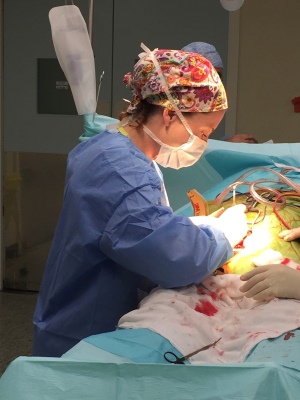Miss Kate Stenson, NIHR Clinical Lecturer in Vascular Surgery
 Miss Kate Stenson performing surgery.
Miss Kate Stenson performing surgery.
What got you interested in clinical academic surgery?
I never planned to be an academic surgeon! My aim was to become a consultant vascular surgeon and I reconciled myself to the fact that I would need to undertake a higher degree in order to be competitive at interview. I had some friends who’d successfully completed MDs and PhDs at St George’s Vascular Institute and of course I was aware of the formidable reputation that the unit had, both clinically and academically. When I started as a research fellow, I was almost immediately struck by the symbiosis between clinical practice and academia that exists in this unit. I was struck by the way the current vascular research was seemingly effortlessly and fluently infiltrated into everyday practice. The senior figures I’ve worked with on both the clinical and academic fronts have been completely inspirational and I was made to feel a part of the team straightaway. This made me realise just how important the world of research was to real life vascular surgery and it made me determined to make myself a part of it.
What was your thesis about and how have you developed your clinical lectureship at St George’s?
My thesis looked at a novel treatment for abdominal aortic aneurysm, called endovascular aneurysm sealing (EVAS). Traditional open surgical repair is a huge operation that inflicts a great physiological insult on patients, who are often elderly with multiple comorbidities. The advent of endovascular techniques to treat this condition in the 1990s opened the avenue of treatment to a great many more patients, who would otherwise not be treated. EVAS was developed as an alternative technique that was thought to be applicable to a wider range of patients and aortic morphologies.
My lectureship has both followed on from this work and developed other associated workstreams. The EVAS series has ongoing follow-up and therefore important results to be reported nationally and internationally. This has led to a great deal of presentations and publications internationally. I have now started looking at the range of treatments that may be used to treat aneurysmal disease of the visceral segment of the aorta, and comparing these techniques and how they affect our patients in terms of clinical and quality of life outcomes.
In addition to my research, I undertake teaching and supervision. I teach medical students at St George’s, as well as junior doctors, nurses and allied health professionals. I have also spoken at events for school students from year 1 to 13! I have a supervisory role for our doctors on the Academic Foundation Programme and I have three PhD students.
How do you manage a work-life balance?
With difficulty! I don’t think there’s a generic right answer to this question. It’s incredibly challenging to balance being a wife, mother, surgeon, trainee and researcher and feel that you’re always doing a good job at each. I have very supportive environments both at home and at work; my husband and I do our best to share childcare duties and we try hard to understand each other’s working patterns. Most of my colleagues at work also have young children and so we all understand the pressures that go with this and we work together to ensure that some sort of balance is achieved! Being able to prioritise and compartmentalise time is essential; work time is for work and family time is for family.